.
Contents...1-10...11-20...21-30...31-40...41-50...51-60...61-70...71-80...81-90
91-100...101-110...111-120...121-130...131-140...141-150...151-156...Index
.
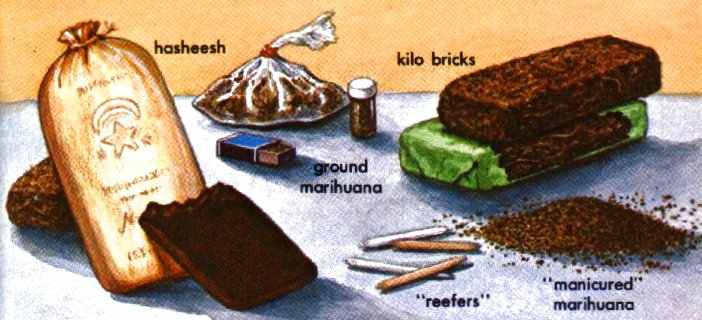

Market forms of cannabis include finely ground or "manicured" marihuana, ''reefers'' (smaller than commercial tobacco cigarettes), pure hasheesh, ond compressed kilo bricks.
Whether cannabis should be classified primarily as a stimulant or depressant or both has never been determined. The drug's activities beyond the central nervous system seem to be secondary. They consist of a rise in pulse rate and blood pressure, tremor, vertigo, difficulty in muscular coordination, increased tactile sensitivity, and dilation of the pupils.
Although cannabis is definitely not addictive, psychological dependence may often result from continual use of the drug.
TURKESTAN MINT (Lagochilus inebrians) is a small shrub of the dry steppes of Turkestan. For centuries it has been the source of an intoxicant among the Tajik, Tartar, Turkoman, and Uzbek tribesmen. The leaves, gathered in October, are toasted, sometimes mixed with stems, fruits, and flowers. Drying and storage increase their aromatic fragrance. Honey and sugar are often added to reduce their intense bitterness.
Valued as a folk medicine and included in the 8th edition of the Russian pharmacopoeia, it is used to treat skin disease, to help check hemorrhages, and to provide sedation for nervous disorders. A crystalline compound isolated from the plant and named lagochiline has proved to be aditerpene. Whether or not it produces the psychoactive effects of the whole plant is unknown. There are some 34 other species of Lagochilus. Members of the mint family, Labiatae, they are native from central Asia to Iran and Afghanistan.
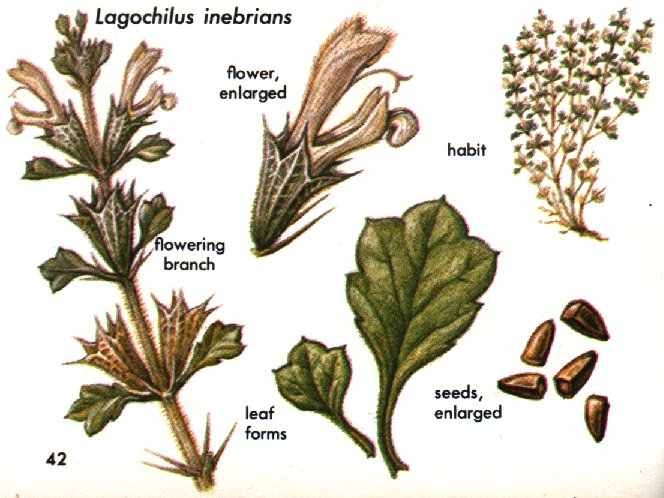
SYRIAN RUE (Peganum harmala) grows from the Mediterranean to northern India, Mongolia, and Manchuria. Everywhere it has many uses in folk medicine. Its seeds have been employed as a spice, and its fruits are the source of a red dye and an oil.
The seeds possess known hallucinogenic alkaloids, especially harmine and harmaline. The esteem in which the peoples of Asia hold the plant is so extraordinary that it might indicate a former religious use as an hallucinogen, but the purposeful use of the plant to induce visions has not yet been established through the literature or field work.
The caltrop family, Zygophyllaceae, to which Syrian rue belongs, comprises about two dozen genera native to dry parts of the tropics and subtropics of both hemispheres.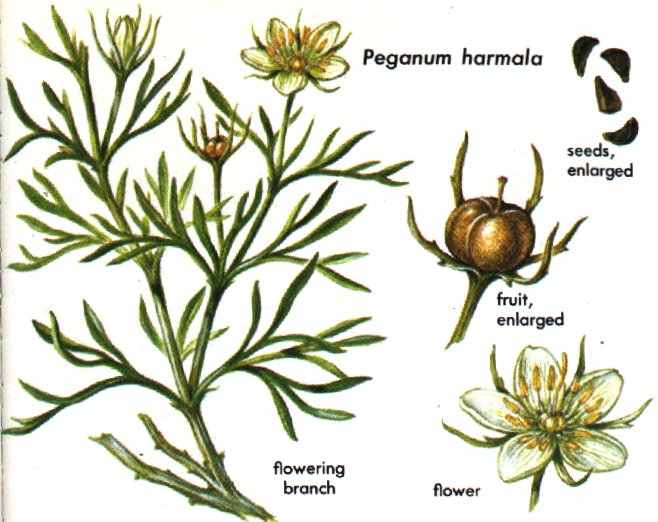
KANNA (Mesembryanthemum expansum and M. tortuosum) is the common name of two species of South African plants. There is strong evidence that one or both were used by the Hottentots of southern Africa as vision inducing narcotics. More than two centuries ago, it was reported that the Hottentots chewed the root of kanna, or channa, keeping the chewed material in the mouth, with these results: "Their animal spirits were awakened, their eyes sparkled and their faces manifested laughter and gaiety. Thousands of delightsome ideas appeared, and a pleasant jollity which enabled them to be amused by simple jests. By taking the substance to excess, they lost consciousness and fell into a terrible delirium."
Since the narcotic use of these two species has not been observed directly, various botanists have suggested that the hallucinogenic kanna may actually have been cannabis or other intoxicating plants, such as several species of Sclerocarya of the cashew family. These two species of Mesembryanthemum do hove the common name kanna, however, and they also contain alkaloids that have sedative, cocaine-like properties capable of producing torpor in man.
In the drier parts of South Africa, there are altogether 1,000 species of Mesembryanthemum - many, like the ice plant, of bizarre form. About two dozen species, including the two described here, are considered by some botanists to represent a separate genus, Sceletium. All belong to the carpetweed family, Aizoaceae, mainly South African, and are believed to be related to the pokeweed, pink, and cactus families.
BELLADONNA (Atropa belladonna) is well known as a highly poisonous species capable of inducing various kinds of hallucinations. It entered into the folklore and mythology of virtually all European peoples, who feared its deadly power. It wos one of the ingredients of the truly hallucinogenic brews and ointments concocted by the so-called witches of medieval Europe. The attractive shiny berries of the plant still often cause it to be accidentally eaten, with resultant poisoning.
The name belladonna ("beautiful lady" in Italian) comes from a curious custom practiced by italian women of high society during medieval times. They would drop the sap of the plant into the eye to dilate the pupil enormously, inducing a kind of drunken or glassy stare, considered in that period to enhance feminine beauty and sensuality.
The main active principle in belladonna is the alkaloid hyoscyamine, but the more psychoactive scopolamine is also present. Atropine has also been found, but whether it is present in the living plant or is formed during extraction is not cleor. Belladonna is a commercial source of atropine, an alkaloid with a wide variety of uses in modern medicine, especially as an antispasmodic, an antisecretory, and as a mydriatic and cardiac stimulant. The alkaloids occur throughout the plant but are concentrated especially in the leaves and roots.
There are four species of Atropa distributed in Europe and from central Asia to the Himalayas. Atropa belongs to the nightshade family, Solanaceae. Belladonna is native to Europe and Asia Minor. Until the 19th century, commercial collection was primarily from wild sources, but since that time cultivation has been initiated in the United States, Europe, and India, where it is an important source of medicinal drugs.
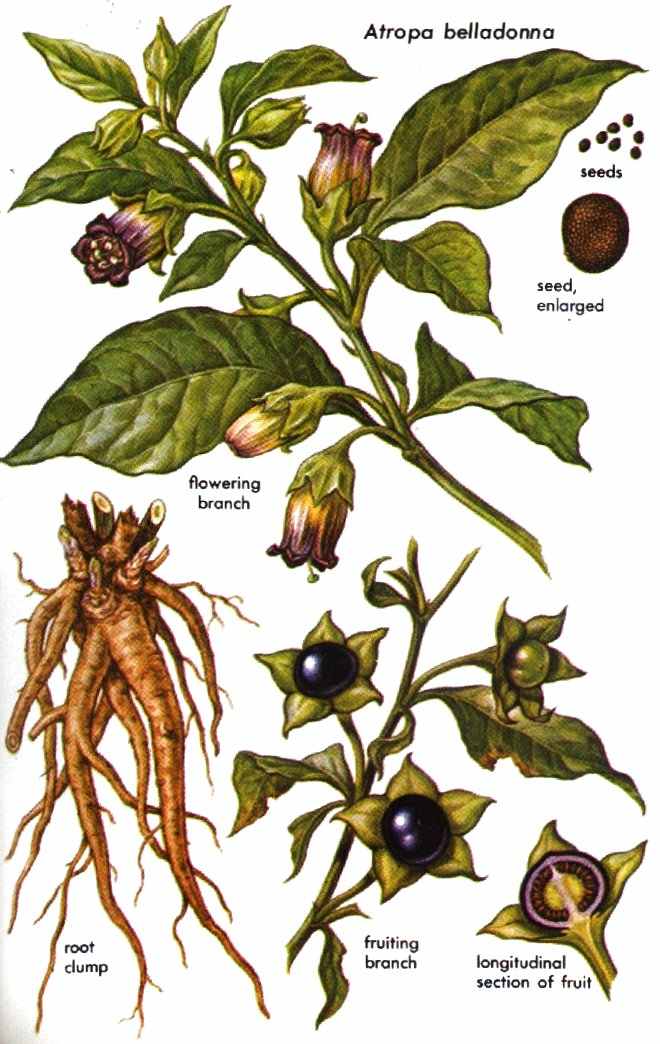
HENBANE (Hyoscyamus niger) was often included in the witches' brews and other toxic preparations of medieval Europe to cause visual hallucinations and the sensation of flight. An annual or biennial native to Europe, it has long been valued in medicine as a sedative and an anodyne to induce sleep.
The principal alkaloid of henbane is hyoscyamine, but the more hallucinogenic scopolamine is also present in significant amounts, along with several other alkaloids in smaller concentrations.
Henbane is one of 20 species of Hyoscyamus, members of the nightshade family, Solanaceae. They are native to Europe, northern Africa, and western and central Asia.
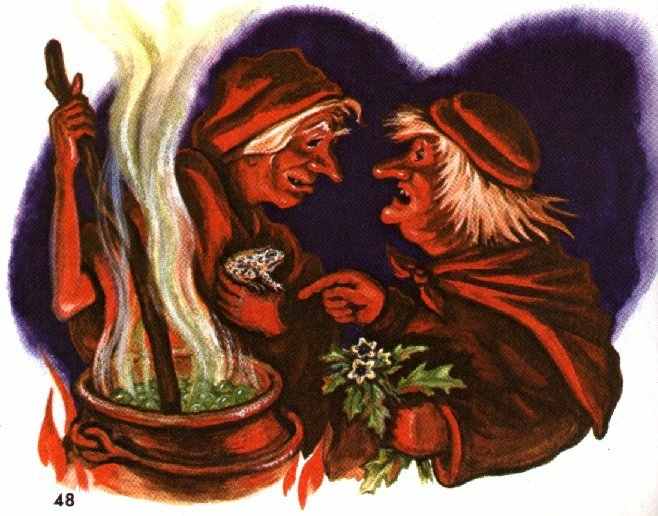
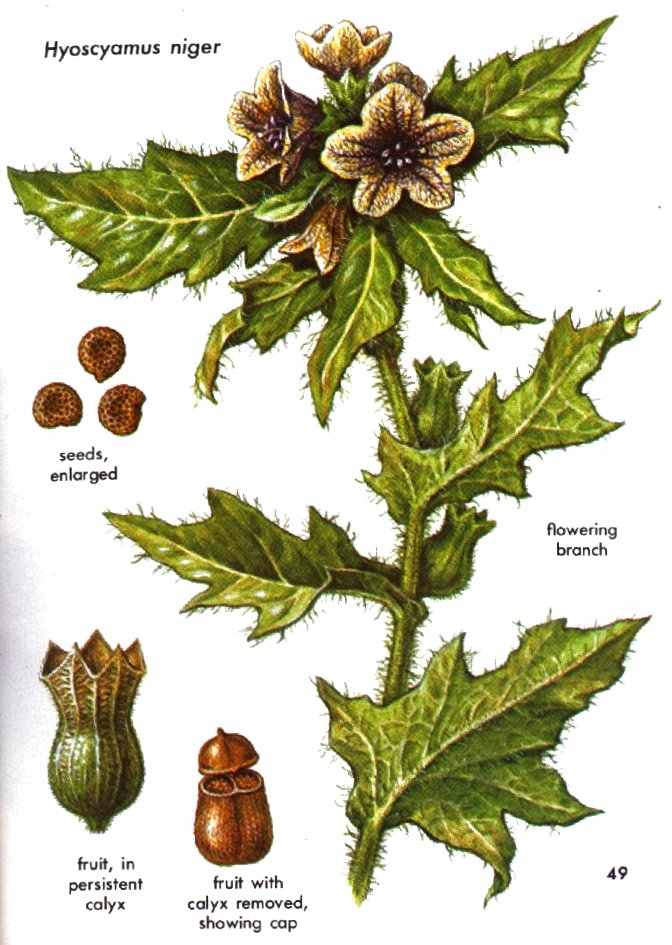
MANDRAKE (Mandragora officinarum), an hallucinogen with a fantastic history, has long been known and feared for its toxicity. Its complex history as a magic hypnotic in the folklore of Europe cannot be equaled by any species anywhere. Mandrake was a panacea. Its folk uses in medieval Europe were inextricably bound up with the "Doctrine of Signatures," an old theory holding that the appearance of an object indicates its special properties. The root of mandrake was likened to the form of a man or woman; hence its magic. If a mandrake were pulled from the earth, according to superstition, its unearthly shrieks could drive its collector mad. In many regions, the people claimed strong aphrodisiac properties for mandrake. The superstitious hold of this plant in Europe persisted for centuries.
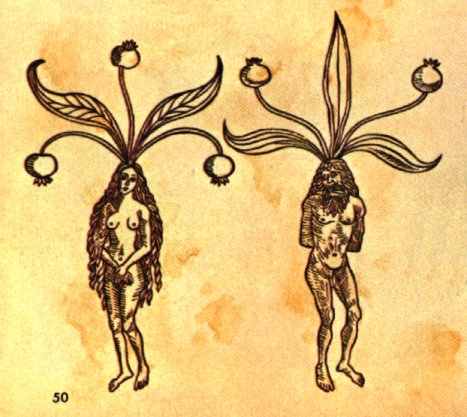
Contents Next